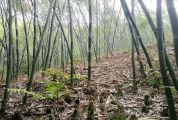 PDF(1545 KB)
PDF(1545 KB)


 PDF(1545 KB)
PDF(1545 KB)
 PDF(1545 KB)
PDF(1545 KB)
硬头黄竹地上生物量分配特征及模型构建
Aboveground biomass allocation patterns and model construction of Bambusa rigida
 ,
,
【目的】探究硬头黄竹不同龄级、径级地上生物量分配特征,建立全竹龄和不同竹龄地上单株及各器官生物量模型,准确估算硬头黄竹的林分生物量。【方法】选取了硬头黄竹全径级(1.0~7.0 cm)分布的1、2、3年生硬头黄竹各50株,测定各器官和总生物量。采用11种常用生物量模型,分别对硬头黄竹全竹龄和不同竹龄地上单株和各器官生物量进行拟合,筛选最优生物量拟合方程,并应用模型估算不同龄级、径级林分总生物量。【结果】硬头黄竹地上竹秆、竹枝、竹叶生物量占比分别为84.82%、10.84%、4.34%;不同龄级单位面积林分总生物量差异显著,竹龄为1、2、3 a竹生物量占比分别为31.92%、47.15%、20.93%;4.6~5.5 cm径级各器官和总生物量显著高于其他径级,占林分生物量的62.60%。11种生物量模型均可以较好地模拟硬头黄竹地上单株及各器官生物量;优选出全竹龄硬头黄竹地上单株和各器官生物量模型6个,不同竹龄的硬头黄竹地上单株和各器官生物量模型19个(1 a的6个、2 a的7个、3 a的6个)。【结论】硬头黄竹不同龄级、径级各器官生物量占比均为竹秆>竹枝>竹叶,林分生物量主要集中在2龄级、4.6~5.5 cm径级的竹株。全竹龄和不同竹龄地上单株与各器官生物量拟合模型中幂函数的拟合效果最优,其次是多项式函数和指数函数;地上单株与竹秆生物量模型拟合效果受胸径、株高的影响较大,竹枝、竹叶生物量模型拟合效果与胸径关系更密切。全竹龄硬头黄竹地上单株和竹秆生物量模型拟合效果均优于不同竹龄的模型,不同竹龄硬头黄竹地上竹枝、竹叶生物量模型拟合效果均优于全竹龄模型的。
【Objective】 We built biometric models to improve the estimation accuracy of aboveground biomass and its allocation patterns in Bambusa rigida for different ages, diameter classes and organs. 【Method】 After selecting B. rigida bamboo pure forests with similar topography, elevation, aspect and slope as the study case, the age and DBH of standing bamboo were investigated. A total of 150 B. rigida individuals(1 a, 2 a, 3 a) with full-diameter classes (1.0-7.0 cm) were selected, and the biomass of different organs and the total biomass were measured. Eleven types of biomass models were applied to model aboveground biomass for individual bamboos and for different organs of different ages of B. rigida. Taking DBH and height of bamboos, and their combined forms (D, D2, DH and D2H) as independent variables, the R software was used to run the biomass models. The coefficient of determination (R2), root mean square error (RMSE) and mean absolute error (MAE) were used to evaluate the models. Finally, the biomass models with the best statistical performances were selected to estimate the total biomass of different ages and diameter classes. 【Result】 The biomass of the culm, branch and leaves of B. rigida made up 84.82%, 10.84% and 4.34% of the total individual bamboo biomass, respectively. Bamboos with a diameter class of 4.6-5.5 cm made up 62.60% of the stand biomass. All 11 types of biomass models can simulate the aboveground biomass of individual bamboo and organs. A total of 176 fitting equations were obtained, with R2 ranging from 0.480 to 0.975, the RMSE ranging from 0.027-0.769 kg, and the MAE ranging from 0.021-0.589 kg. Six models of the aboveground biomass of individual bamboos and organs of all age classes were selected, and 19 models of aboveground biomass of individual bamboos and organs of different age classes were selected (6 of 1 a, 7 of 2 a, 6 of 3 a). 【Conclusion】 The proportion of biomass of different organs in different ages and diameter classes of B. rigida was in the order of culm > branch > leaf. With the increase in age, the proportion of bamboo stalk biomass decreased significantly, while the proportion of bamboo branch biomass increased significantly. In contrast, the proportion of bamboo stalk biomass generally increased, while the proportion of bamboo branches and leaf biomass generally decreased with increasing diameters. The stand biomass was dominated by the age class of 2 a or the diameter class of 4.6-5.5 cm. The fitting effect of the power function was the best, followed by the polynomial function and exponential function. The aboveground biomass of individual bamboos and culms was greatly affected by DBH and plant height, and the biomass of branches and leaves was more closely related to DBH. The model performances of the aboveground biomass models of individual bamboos and culms, regardless of age class, were better than those of different age classes, and the model performances of the aboveground biomass models of branch and leaf, regardless of age class, were better than those of different age classes. In this study, a large number of B. rigida were selected by refining age classes and diameter classes, and the biomass allocation patterns of B. rigida were studied in different diameter classes and age classes. Additionally, various mathematical models were used to construct and select the optimal models. Estimating stand biomass and further obtaining its stock and allocation patterns is important for refining biomass estimation and guiding production and management of bamboo forests.

Bambusa rigida / age class / diameter class / allocation patterns / biomass model
| [1] |
中国科学院中国植物志编辑委员会. 中国植物志:第九卷第一分册[M]. 北京: 科学出版社, 1996.
|
| [2] |
汪淑芳, 梁梓, 杨瑶君, 等. 不同秆龄慈竹竹秆含水率与生物量的分配特征及其生物量模型的构建[J]. 西部林业科学, 2013,42(1):42-45.
|
| [3] |
唐建维, 萧自位, 王小李, 等. 西双版纳不同林龄人工龙竹林的生物量及其模型[J]. 中南林业科技大学学报, 2011,31(12):54-60.
|
| [4] |
徐道旺, 陈少红, 杨金满. 毛环竹笋用林生物量结构调查分析[J]. 福建林业科技, 2004,31(1):67-70.
|
| [5] |
王海霞, 彭九生, 曾庆南. 淡竹立竹生物量计算模型构建[J]. 世界竹藤通讯, 2014,12(6):6-10.
|
| [6] |
苏文会, 顾小平, 官凤英, 等. 大木竹种群生物量结构及其回归模型[J]. 南京林业大学学报(自然科学版), 2006,30(5):51-54.
|
| [7] |
鹿士杨, 潘丽萍, 彭晚霞, 等. 不同竹类人工林生态系统生物量空间分配格局[J]. 生态科学, 2018,37(4):123-129.
|
| [8] |
王曙光, 普晓兰, 丁雨龙, 等. 云南箭竹地上部分生物量模型研究[J]. 南京林业大学学报(自然科学版), 2010,34(1):141-144.
|
| [9] |
杨清, 苏光荣, 段柱标, 等. 版纳甜龙竹种群生物量结构及其回归模型[J]. 西北农林科技大学学报(自然科学版), 2008,36(7):127-134.
|
| [10] |
夏载深, 李秋枫. 硬头黄竹生长规律观察研究[J]. 重庆林业科技, 1991(2):12-18.
|
| [11] |
周益权, 顾小平, 吴晓丽, 等. 丛生竹秆基各笋目的出笋成竹生物学特性研究[J]. 林业科学研究, 2011,24(3):314-320.
调查了西南地区人工栽培的梁山慈竹、撑绿竹、硬头黄竹着生于秆基两侧的4对大型芽(又叫笋目、芽眼、芽目)的出笋成竹生物学特性,计算各年龄母竹和各笋目位置的出笋率、成竹率、新竹相对生长率。结果表明:随着母竹年龄的增加,出笋成竹能力明显下降,1年生母竹出笋成竹能力最强,2年生母竹迅速下降,3年生母竹基本丧失繁殖能力;各笋目的出笋成竹能力为2目>头目>3目>4目,3目、4目显著低于头目、2目。综合分析母竹年龄和笋目位置表明:1年生母竹的头目、2目萌发力最强,是留笋长竹的最佳笋芽。通过有序样本聚类分析,将3个竹种的出笋期划分为初期、盛期和末期,初期出笋数少但成竹率高,中后期出笋数增加,但成竹率却明显下降;笋目萌发年龄和出笋时间与笋目位置有关,分布在秆基中下部的头目、2目萌发年龄较早,在出笋期的出笋时间也较早,而位于秆基中上部的3目、4目萌发年龄较迟,出笋时间也较晚。根据各笋目的出笋成竹特性,从抚育、间伐和水肥管理等方面提出了调控林分出笋的经营管理对策。
|
| [12] |
郑郁善, 梁鸿燊. 绿竹生物量模型研究[J]. 竹子研究汇刊, 1997,16(4):43-46.
|
| [13] |
张宇, 岳祥华, 漆良华, 等. 利用异速生长关系和地统计方法估算武夷山南麓毛竹林生物量[J]. 生态学杂志, 2016,35(7):1957-1962.
澄清毛竹(Phyllostachys edulis)生物量与胸径之间的异速生长关系及毛竹林生物量密度与叶面积指数之间的关系有助于准确估算毛竹林生物量。本文结合异速生长关系和地统计方法对中尺度毛竹林生物量进行估算。利用收获法在武夷山南麓毛竹林分布区砍伐103棵标准竹,并用冠层分析仪获取毛竹林叶面积指数,建立毛竹生物量与胸径、林分生物量密度与叶面积指数的异速生长关系;再利用地统计方法对黄坑镇毛竹林生物量的空间分布进行模拟。结果表明:武夷山南麓毛竹单株生物量与胸径之间存在明显的幂函数关系(R2=0.585,P=0.002);毛竹林生物量密度与叶面积指数间也存在着显著的幂函数关系(R2=0.525,P=0.002);利用建立的异速生长方程和地统计方法对黄坑镇毛竹林地上生物量的模拟结果表明,黄坑镇毛竹林平均地上生物量密度为53.49 t·hm-2,全镇毛竹林地上生物量约为0.62 Tg。
|
| [14] |
黎曦. 赣南毛竹、硬头黄竹、坭竹等竹林生物量的研究[D]. 南京:南京林业大学, 2007.
|
| [15] |
张鹏, 黄玲玲, 张旭东, 等. 滩地硬头黄竹生物量结构及回归模型的研究[J]. 竹子研究汇刊, 2009,28(3):25-28.
|
| [16] |
曹明勇. 长宁县竹林生物量及初级生产力特征研究[D]. 长沙:中南林业科技大学, 2016.
|
| [17] |
陈霖. 宜宾市3个竹种地上部分生物量表的编制[D]. 雅安:四川农业大学, 2015.
|
| [18] |
李燕, 张建国, 段爱国, 等. 杉木人工林生物量估算模型的选择[J]. 应用生态学报, 2010,21(12):3036-3046.
采用11种形式的生物量模型,分别对杉木幼龄林(7年生)、中龄林(16年生)、成熟林(28年生)和不分林龄的单木各器官和全株生物量进行拟合,共得到生物量估算模型308个.结果表明: 11种生物量模型均能较好地模拟杉木单木生物量,其中幂函数模型的拟合效果最优,其次为指数模型,然后为多项式模型;共选出估算杉木幼龄林、中龄林和成熟林各器官和全株生物量的最优模型21个(包括18个器官模型、3个全株模型),不分林龄的杉木单木各生物量的最优模型7个(包括6个器官模型、1个全株模型),均为幂函数模型;不同林龄的杉木单木生物量最优模型的通用性较差,而不分龄林的杉木单木生物量最优模型具有一定的通用性,精度较高,可用于估算不同林龄的杉木单木生物量.应用福建邵武杉木单木生物量模型对江西28年生的杉木成熟林单木各生物量的预测结果显示,不分林龄的大样本生物量模型精度较高,可在较大范围内应用,而区域小样本模型仅限于在区域小范围内应用.
|
| [19] |
王太鑫, 丁雨龙, 李继清, 等. 巴山木竹种群生物量结构研究[J]. 竹子研究汇刊, 2005,24(1):19-24.
|
| [20] |
王维芳, 董薪明, 董小枫, 等. 森林生物量的空间自相关性研究[J]. 森林工程, 2018,34(2):35-39.
|
| [21] |
朱强根, 金爱武, 陈操, 等. 毛竹克隆构型及其生物量对不同营林模式的响应[J]. 南京林业大学学报(自然科学版), 2015,39(1):73-78.
|
/
| 〈 |
|
〉 |